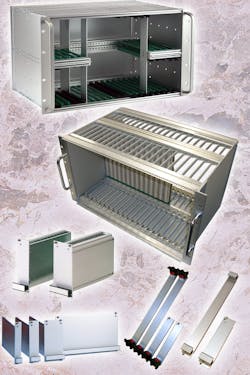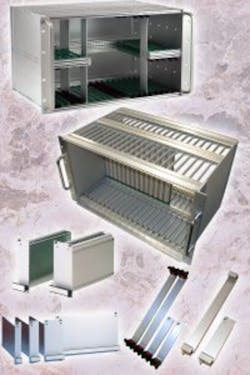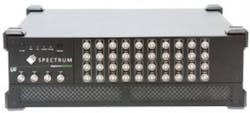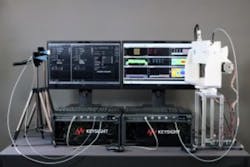Instrumentation platforms facilitate testing
PXI (PCI eXtensions for instrumentation) has been in use for close to 20 years, while LXI (LAN eXtensions for instrumentation) is newer to the automated testing scene. Older platforms, including GPIB and VXI, remain in use today, but LXI seems to be gathering momentum due to electronics engineering’s need for increasing bandwidths, faster data transfer rates, and lower costs. According to the LXI Consortium on its website, “LXI is the next-generation instrumentation platform. LXI is based on industry standard Ethernet technology and provides the flexibility and performance, commonplace on larger VXI systems, to small- and medium-sized systems.”
The VXI architecture, which is now more than 30 years old, has been widely used in the aerospace and defense industries due its high performance, modularity, and compact footprint. However many companies are now not able to continue supporting the standard.
At the same time, PXI—generally Windows-centric—is alive and well. It and LXI use a different control model so they have different strengths and weaknesses. PXI focuses on a central processing model, using products that are modular and reliant on a high-speed data bus for communicating with the central processor that provides the computing power needed to perform system functions. A PXI instrument inserted in the system appears to the operating system as a device just like a PCI card in a personal computer. LXI uses a more distributed control and data-processing system that communicates via a reasonably fast interface—a model that has some similarities to GPIB.
Card cage family
The KM6 card-cage family system, which conforms to DIN41494 and IEC60297, strives for comprehensiveness and versatility. The flagship KM6-II was first introduced 30 years ago. The much newer heavy-duty KM6-HD units meet the requirements of MIL-STD-167, offering a combination of strength, versatility, and configurability. KM6-II is available asPXI optical-test modules
This new portfolio of PXI optical-test modules includes optical switches, optical-electrical converters, and variable optical attenuators. Engineers can combine the new PXI optical-test capability with a range of NI PXI instruments to drive mixed-signal test in various optical-test applications from design through production. The new optical modules integrate seamlessly with NI’s electrical signal generation and analysis modules and can be automated using similar APIs. As a result, engineers can simplify the design of optical test systems from wafer level up to pluggable modules and systems. Engineers can use optical PXI test modules either in standalone PXI systems in the design or characterization lab, or as part of a fully integrated Semiconductor Test System solution.
Coherent Solutions
4-channel PXI SMU
The new GX3104 4-channel PXI source measure unit (SMU) is a precision 3U PXI module that forces and senses both voltage and current over a range of ±20 V and up to ±1 A. ThePXI SMU for semiconductor test
The PXIe-4163 high-density source-measure unit (SMU) provides more DC channel density than the vendor’s previous PXI SMUs for testing RF, MEMS, and mixed-signal and other analog semiconductor components. The vendor says chipmakers have rapidly adopted its Semiconductor Test System (STS) for its throughput, performance at cost, and footprint on the production floor. The new PXIe-4163 SMU further complements these capabilities. It delivers increased DC channel density for higher parallelism in multisite applications and lab-grade measurement quality in a production-ready form factor. Engineers can use the new PXIe-4163 SMU in either STS configurations or stand-alone PXI systems. Key product features include up to 24 channels in a single PXI Express slot; ±24 V per channel, up to 100mA current sensitivity, interactive configuration and debug software, and up to 408 high-precision SMU channels in a single PXI chassis. National Instruments
Data-acquisition instruments
Twelve new products in the vendor’s family of LXI-based digitizerNETBOX data-acquisition instruments are designed specifically for situations where multiple signals need to beEach channel of a digitizerNETBOX has its own ADC and signal-conditioning circuitry. The ADCs all share a common clock so that the acquisitions made on all the channels are fully synchronous and have zero phase error. The design of the clocking system ensures that cross-channel timing measurements are made with the highest possible precision while the independent signal conditioning enables the units to be used with signals that have a range of amplitudes. Spectrum Instrumentation
Fast-recording PXIe disk controller
The StreamStor Cobra PXIe high-speed recorder guarantees sustained data streaming and high-speed recording capabilities at speeds up to 17 GB/s (136 Gb/s) with zero data loss. The Cobra PXIe disk controller is the latest in a series of this vendor’s line of high-speed StreamStor PCI Express disk controllers for recording and playback of digital data. Cobra’s main recording engine is a PXI Express board with high-speed RAM and a high-performance Xilinx FPGA, which manages the movement of data to and from storage devices and also provides optical-fiber channels for high-speed data input or output. A single Cobra PXIe disk controller board supports peer-to-peer data recording with sustained recording and playback speeds up to 5 GB/s second (40 Gb/s). In a chained optical arrangement, more than 17 GB/s with zero data loss is achievable. Other key features include support of data-transmission protocols including Aurora, Interlaken, and Serial FPDP with up to 24 lanes of fiber-optic I/O (48 fibers) at data rates of up to 12.5 Gb/s per lane. Data-storage capacities are available up to 48 TB of NVMe solid-state drive storage. Standalone operation via Ethernet or PCIe host system command/control is available. Conduant
USB/LXI chassis
The Model 60-105 4-slot USB/LXI modular chassis complements the vendor’s 2-slot version in that they both offer a small, lightweight form-factor suitable for portable, benchtop, and space-restrictive applications. These chassis are designed for desk or rack mounting and feature remote control via USB or LXI Ethernet. Remote control over a network enables the switching function of a test system to be located as close as possible to the target equipment. This new 4-slot chassis supports between one and four of the vendor’s 3U PXI modules; possible switching configurations include 6 x SP6T 40-GHz MUX or 2 x 32:1 terminated 600-MHz MUX. Both the 2-slot and the 4-slot chassis are USB-3 compatible and have a fully compliant LXI interface. These communication standards enable the chassis to be controlled directly through standard interfaces found on most personal computers and tablets that support HTML5, allowing for a practical route into a variety of applications in the modular test and measurement market. Pickering Interfaces




